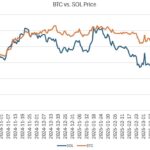In a significant move for the decentralized finance (DeFi) sector, Aave has announced that users can now supply and borrow Ripple’s RLUSD stablecoin on its V3 Ethereum Core market. This update, shared in a recent post on social media platform X, marks an exciting development for those involved in the peer-to-peer loan landscape.
The RLUSD stablecoin, which is pegged 1:1 to the U.S. dollar, is available on both the XRP Ledger and Ethereum blockchain. Aave’s market for RLUSD features a supply cap set at 50 million tokens and a borrowing cap of 5 million tokens, allowing users the ability to engage in borrowing and lending on a sizable scale. Backed fully by U.S. dollar deposits, short-term U.S. Treasuries, and cash equivalents, each RLUSD is matched to an equivalent fiat value, bolstering its stability.
An interesting aspect of RLUSD is its security features that make it particularly attractive to institutional users. Following an amendment on the XRP Ledger earlier this year, a “clawback” feature has become operational. This functionality allows the issuer to reclaim specific tokens from users’ wallets under predetermined conditions, providing an additional layer of security.
Industry experts note that the introduction of RLUSD may alter the dynamics within the cryptocurrency market significantly. Currently, Tether’s USDT holds the title of the largest stablecoin, followed closely by Circle’s USDC. However, as Ripple’s RLUSD gains traction, it could present robust competition for these incumbents, while simultaneously enhancing the allure of Ripple’s native token, XRP, among investors seeking new opportunities in this evolving landscape.

Aave Integrates Ripple’s RLUSD Stablecoin
Recent developments in the decentralized finance (DeFi) space highlight the integration of Ripple’s RLUSD stablecoin into the Aave platform, presenting several implications for users and the broader crypto market.
- Supply and Borrow Limits:
- Supply cap: 50 million RLUSD
- Borrow cap: 5 million RLUSD
- Stablecoin Characteristics:
- RLUSD is pegged 1:1 to the U.S. dollar.
- It is backed by U.S. dollar deposits, short-term U.S. Treasuries, and cash equivalents.
- Security Features:
- Includes a “clawback” feature that allows token issuers to reclaim tokens from user wallets under specific conditions.
- This feature enhances security, making it appealing to institutional users.
- Market Competition:
- RLUSD could compete with leading stablecoins like Tether’s USDT and Circle’s USDC, potentially reshaping the stablecoin landscape.
- Industry leaders anticipate that the introduction of RLUSD will influence crypto market dynamics significantly.
- Impact on XRP’s Appeal:
- The growth of RLUSD is expected to enhance the attractiveness of XRP among investors.
- A higher adoption rate for RLUSD might indicate a resurgence in interest for the XRP Ledger.
This development not only broadens the lending options for Aave users but also signals potential shifts within the stablecoin market that could affect investment strategies and asset management in the crypto domain.
Aave Welcomes Ripple’s RLUSD: A Game-Changer in Stablecoins
The recent announcement from Aave about the integration of Ripple’s RLUSD stablecoin into their decentralized lending platform marks a notable shift within the stablecoin landscape. As crypto market participants are well aware, stablecoins play a critical role in providing fluidity to trading and lending operations. However, the introduction of RLUSD adds a layer of competitive tension, especially for long-standing players like Tether’s USDT and Circle’s USDC.
Competitive Advantages: One of the standout features of RLUSD is its strong backing by U.S. dollar deposits and short-term Treasuries, appealing particularly to institutional users who prioritize security and reliability. The “clawback” feature implemented on the XRP Ledger could address compliance concerns, making RLUSD not only secure but also regulatory-friendly, a critical factor for more traditional financial institutions dipping their toes into crypto. Furthermore, being available on both Ethereum and the XRP Ledger significantly broadens its accessibility, potentially driving adoption among diverse user bases.
Competitive Disadvantages: However, the launch is not without its drawbacks. The supply cap of 50 million RLUSD and a borrowing cap of 5 million may limit the immediate usability for larger institutions or aggregators needing to transact significant volumes. This could pose challenges for users seeking liquidity compared to more established stablecoins with larger circulations. Additionally, the newness of RLUSD may lead to initial skepticism among users who are accustomed to the reliability and established trust of USDT and USDC. The familiar market infrastructure built around these incumbents presents a formidable barrier for newcomers like Ripple.
Who Benefits: Retail and institutional users that prioritize security and are receptive to innovative mechanisms will likely benefit from RLUSD’s introduction. It could be especially useful to those keen on exploring decentralized finance (DeFi) without compromising on stability or asset safety. The move might also offer fresh avenues for investors interested in diversifying their crypto portfolios, particularly in light of the growing interest in the XRP ecosystem, which may draw attention with the new stablecoin.
Potential Problems: Alternatively, established stablecoin players may see shifts in market share, presenting both risks and an urgent call to innovate. Entities heavily invested in USDT and USDC might feel pressure to reassess their strategies to retain user trust and liquidity amid competition. Furthermore, any missteps or regulatory scrutiny faced by RLUSD, especially concerning the clawback feature, could create negative ripple effects across the wider crypto landscape.















